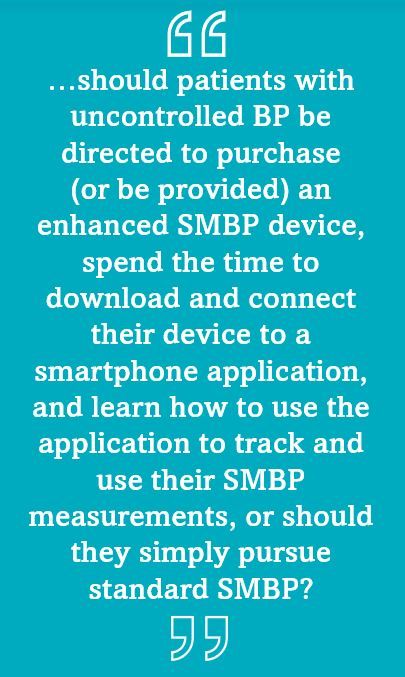Self-measured BP Using Smartphone App No More Effective than Using Standard Device to Reduce Hypertension

Self-measured blood pressure (SMBP) using a commercially available enhanced device that pairs with a smartphone application was found no more effective than standard self-monitoring for reducing BP or improving patient satisfaction, according to researchers from the University of California San Francisco (USCF).
The PCORnet Blood Pressure Home Monitoring Study, or BP Home, a simple pragmatic randomized clinical trial designed to compare the 2 monitoring approaches used in real world settings, found no significant difference in impact on hypertension between the enhanced and standard BP measurement arms, with mean reductions of systolic blood pressure (SBP) of approximately 11 mm Hg in each.

The authors cite research that suggests the more support offered to patients engaged in home BP monitoring, the better the treatment results. Given the expense of implementing such programs, the UCSF team thought the enhanced technology of commercially available, app-enhanced devices could be a proxy for that cointervention and valuable for patients—potentially more valuable than basic home devices that simply display blood pressure.
To compare the effectiveness of the 2 device types in lowering SBP, UCFS investigators in collaboration with the National Patient-Centered Clinical Research Network (PCORnet), enrolled patients from 23 PCORnet practice sites throughout the country who self-reported a SBP >145 mm Hg at their most recent clinic visit, were committed to reducing their BP, and owned a smartphone.
Eligible participants were enrolled after completing baseline surveys and randomization to 1 of 2 intervention groups commenced August 3, 2019, ending December 31, 2020.
Randomization was to SMBP with a standard BP monitor or with an enhanced BP monitor with accompanying smartphone application. According to the study authors, all materials were provided through the mail and there was no engagement with clinicians at any point during the study.
Participants were followed for 6 months with investigators' primary interest in reduction in SBP, defined as the difference between clinic self-reported SBP at baseline and clinic SBP at the most recent visit during the 6-month follow-up. Data for the measure were extracted from electronic health records.
Secondary outcomes included reduction in diastolic BP, BP control (to <140/<90 mm Hg, and to <130/<80 mm Hg), and patient-reported survey outcomes at 6 months.
FINDINGS
Final enrollment was 2101 participants, with 1050 randomized to use of standard SMBP and 1051 to enhanced SMBP with smartphone. Mean age was 58 (SD, 13) years. Men comprised 43% of the cohort, 31% were non-Hispanic Black or Hispanic individuals. The most common comorbidity reported was diabetes (~20%) followed by coronary artery disease (~8%) and the team found that the majority of participants had used hypertension medications. The majority also were comfortable using technology.
The investigators report the mean reduction in SBP from baseline to 6 months was 10.8 (SD, 18) mm Hg in the group using the smartphone application and -0.6 (SD, 18) mm Hg in the standard group (adjusted difference, -0.19 mm Hg; 95% CI, -1.83 - 1.44; P=.81). When they analyzed secondary BP outcomes those also were mostly null, although investigators did document BP control to <140/90 mm Hg among 32% in the group using the enhanced device with smartphone app and 29% in the group using the standard SMBP device (OR, 1.15 [95% CI, 1.01 - 1.34]).
Responding to a questionnaire about satisfaction with the method of BP monitoring used, most participants reported being very likely to recommend their particular SMBP device to a friend, whether it was the enhanced (70%) or the standard (69%) version.
Responding to a questionnaire about satisfaction with the method of BP monitoring used, most participants reported being very likely to recommend their particular SMBP device to a friend, whether it was the enhanced (70%) or the standard (69%) version.
The investigators rephrase the question that prompted the study: “…should patients with uncontrolled BP be directed to purchase (or be provided) an enhanced SMBP device, spend the time to download and connect their device to a smartphone application, and learn how to use the application to track and use their SMBP measurements, or should they simply pursue standard SMBP?”
In conclusion, they write: “The answer from BP Home is clear: there is no significant benefit from enhanced vs standard SMBP when delivered without additional cointerventions or support. Enhanced SMBP does not provide any additional reduction in BP, and patients would not recommend an enhanced SMBP device to their peers more than a standard device,” wrote investigators.
Reference: Pletcher MJ, Fontil V, Modrow MF, et al. Effectiveness of standard vs enhanced self-measurement of blood pressure paired with a connected smartphone application. JAMA Intern Med. Published online August 15, 2022. doi:10.1001/jamainternmed.2022.3355